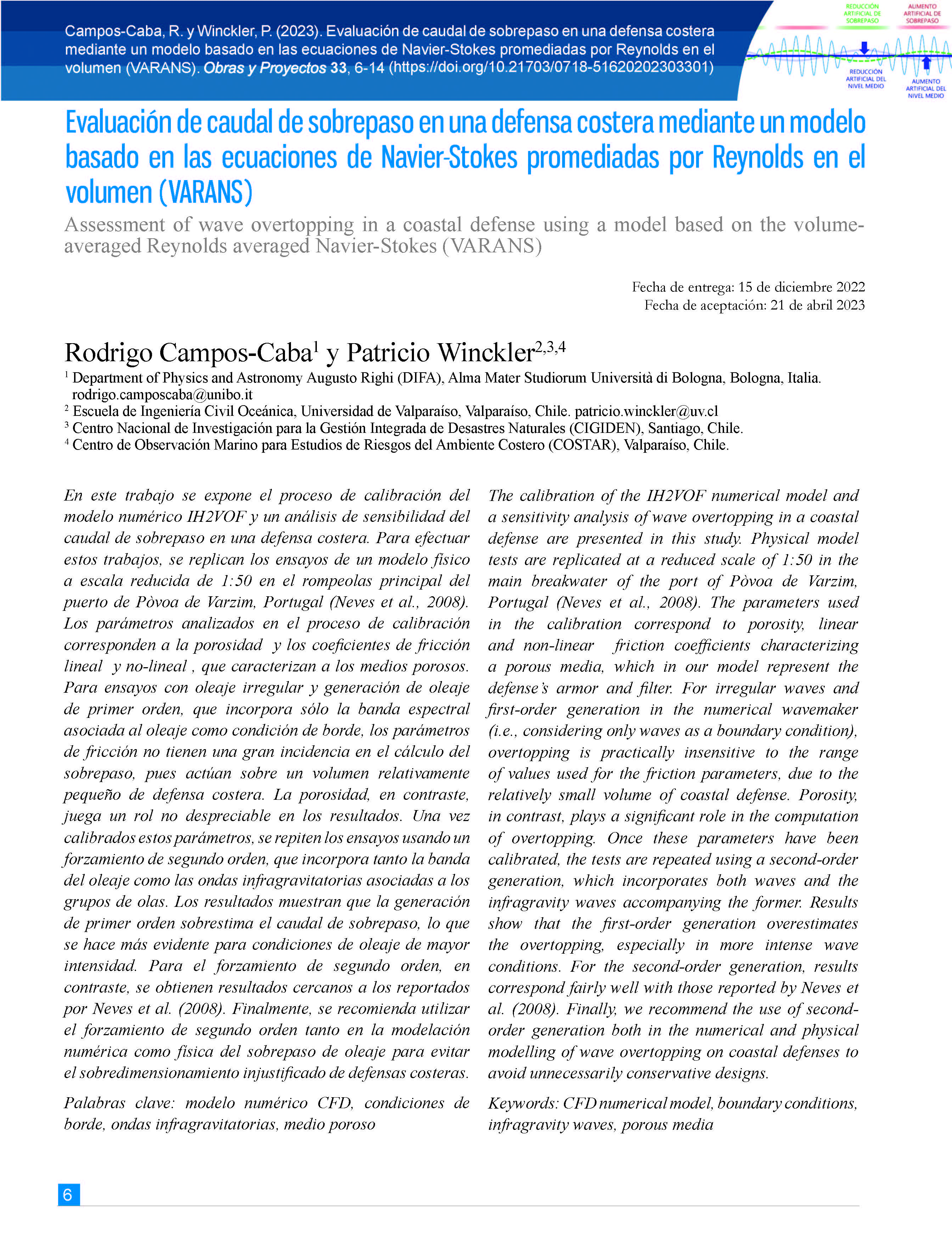Evaluación de caudal de sobrepaso en una defensa costera mediante un modelo basado en las ecuaciones de Navier-Stokes promediadas por Reynolds en el volumen (VARANS)
DOI:
https://doi.org/10.21703/0718-281320233301Palabras clave:
Modelo numérico CFD, Condiciones de borde, Ondas infragravitatorias, Medio porosoResumen
En este trabajo se expone el proceso de calibración del modelo numérico IH2VOF y un análisis de sensibilidad del caudal de sobrepaso en una defensa costera. Para efectuar estos trabajos, se replican los ensayos de un modelo físico a escala reducida de 1:50 en el rompeolas principal del puerto de Pòvoa de Varzim, Portugal (Neves et al., 2008). Los parámetros analizados en el proceso de calibración corresponden a la porosidad y los coeficientes de fricción lineal y no-lineal , que caracterizan a los medios porosos. Para ensayos con oleaje irregular y generación de oleaje de primer orden, que incorpora sólo la banda espectral asociada al oleaje como condición de borde, los parámetros de fricción no tienen una gran incidencia en el cálculo del sobrepaso, pues actúan sobre un volumen relativamente pequeño de defensa costera. La porosidad, en contraste, juega un rol no despreciable en los resultados. Una vez calibrados estos parámetros, se repiten los ensayos usando un forzamiento de segundo orden, que incorpora tanto la banda del oleaje como las ondas infragravitatorias asociadas a los grupos de olas. Los resultados muestran que la generación de primer orden sobrestima el caudal de sobrepaso, lo que se hace más evidente para condiciones de oleaje de mayor intensidad. Para el forzamiento de segundo orden, en contraste, se obtienen resultados cercanos a los reportados por Neves et al. (2008). Finalmente, se recomienda utilizar el forzamiento de segundo orden tanto en la modelación numérica como física del sobrepaso de oleaje para evitar el sobredimensionamiento injustificado de defensas costeras.
Referencias
Allsop, N.W.H., Bruce, T., De Rouck, J., Kortenhaus, A., Pullen, T., Schüttrumpf, H., Troch, P. and Zanuttigh, B. (2016). EurOtop II Manual on wave overtopping of sea defences and related structures: An overtopping manual largely based on European research, but for worldwide application. Second edition. HR Wallingford, UK.
Beyá, I. (2017). Comparación del sobrepaso del oleaje en canales experimentales, utilizando teorías de generación de oleaje de 1er y 2do orden. Caso de análisis: Av. Perú, Viña del Mar, Chile, en canal bidimensional del Instituto Nacional de Hidráulica. XXIII Congreso Chileno de Ingeniería Hidráulica, Universidad Santa María, Valparaíso, Chile, artículo 52.
Di Lauro, E., Lara, J.L., Maza, M., Losada, I.J., Contestabile, P. and Vicinanza, D. (2019). Stability analysis of a nonconventional breakwater for wave energy conversion. Coastal Engineering 145, 36-52.
Fritz, S. (2018). Estudio del sobrepaso en avenida Perú mediante el software CFD - olaFOAM. Memoria del proyecto para optar al Título de Ingeniero Civil Oceánico. Universidad de Valparaíso, Chile.
García, N., Lara, J.L. and Losada, I.J. (2004). 2D numerical analysis of near-field flow at low-crested permeable breakwaters. Coastal Engineering 51(10), 991-1020.
Guanche, R., Losada, I.J. and Lara, J.L. (2009). Numerical modelling of coastal structures stability. Coastal Engineering 56(5-6), 543-558.
Lara, J.L. (2005). A numerical wave flume to study the functionality and stability of coastal structures. Journal of the International Navigation Association (PIANC) 121: 5-29.
Lara, J.L., Garcia, N. and Losada, I.J. (2006). RANS modelling applied to random wave interaction with submerged permeable structures. Coastal Engineering 53(5-6), 395-417.
Losada I.J., Lara J.L., Christensen E.D. and Garcia, N. (2005). Modelling of velocity and turbulence fields around and within low-crested rubble-mound breakwaters. Coastal Engineering 52(10-11), 887-913.
Losada, I.J., Lara, J.L., Guanche, R. and Gonzalez-Ondina, J.M. (2008). Numerical analysis of wave overtopping of rubble mound breakwaters. Coastal Engineering 55(1), 47-62.
Neves, M.G., Reis, M.T., Losada, I.J., Asce, M., Keming, H. (2008). Wave overtopping of Póvoa de Varzim breakwater: physical and numerical simulations. Journal of Waterways, Port, Coastal and Ocean Engineering 134(4), 226-236.
Pedersen, J. (1996). Wave forces and overtopping on crown walls of rubble mound breakwaters: an experimental study. Aalborg Universitetsforlag. Series paper No. 12, Denmark.
USACE (2011). Coastal engineering manual, part VI, chapter 5: Fundamentals of design. US Army Corps of Engineers. USA.
Winckler, P., Contreras-López, M., Campos-Caba, R., Beya, J. y Molina, M. (2017). El temporal del 8 de agosto de 2015 en las regiones de Valparaíso y Coquimbo, Chile Central. Latin American Journal of Aquatic Research 45(4): 622-648.
Winckler, P., Esparza, C., Agredano, R. y Ibaceta, R. (2019). Nuevas metodologías para el estudio de marejadas en Chile. En Martínez, C., Hidalgo, R., Henríquez, C., Arenas, F., Rangel, N. y Contreras-López, M. (eds.). La Zona Costera en Chile: Adaptación y Planificación para la Resiliencia. Serie GEOlibro Nº 31, Instituto de Geografía, Pontificia Universidad Católica de Chile, Santiago, Chile.

Descargas
Publicado
Número
Sección
Licencia

Esta obra está bajo una licencia internacional Creative Commons Atribución-NoComercial 4.0.







